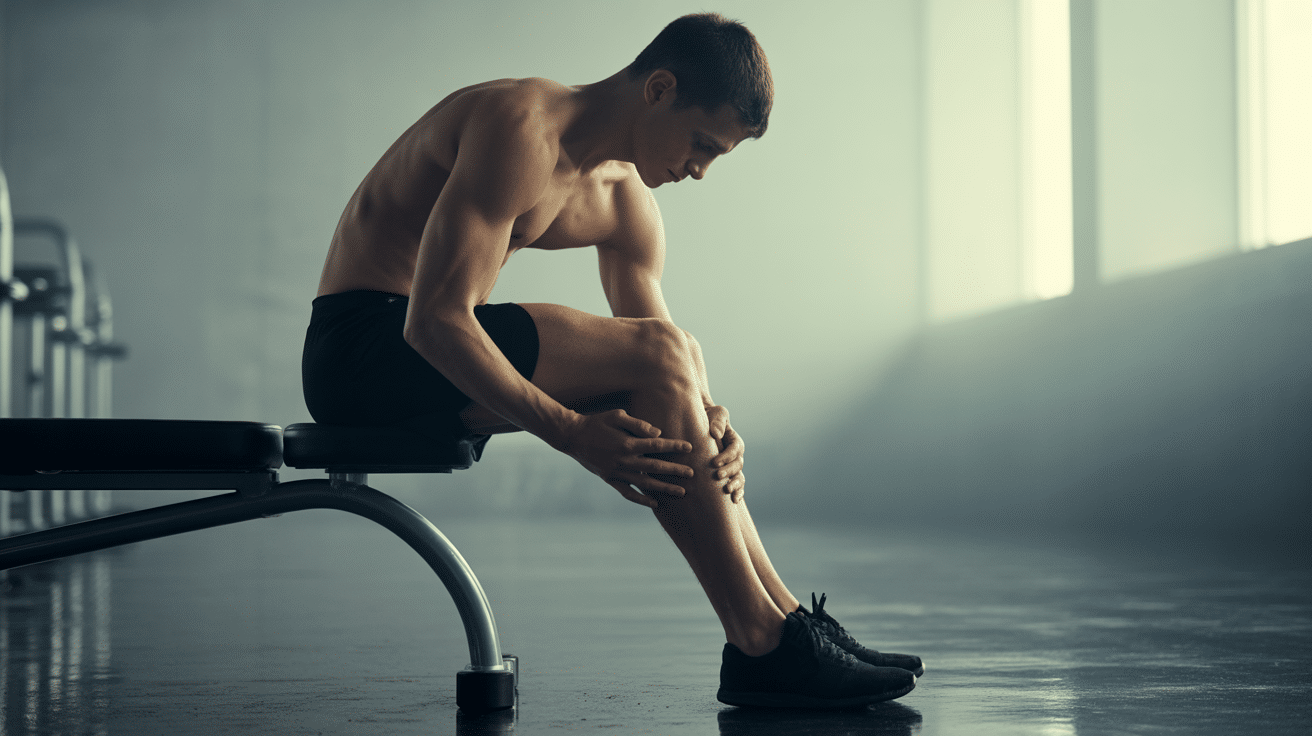I know that sore feeling after a workout, the kind that makes climbing stairs or sitting down a challenge. You might wonder if that soreness is proof that your muscles are growing stronger. It’s a common thought, but the truth is a bit more complicated.
Soreness can reveal something about how your body responds to training, but it isn’t the most accurate way to measure progress.
In this blog, I’ll walk you through what soreness really means, answer the question of whether being sore is a good sign of muscle growth, and share better ways to track your progress. That way, you can train smarter and recover with confidence.
Is Being Sore a Good Sign of Muscle Growth?
The short answer: not always. While soreness can mean you stressed your muscles in a new way, it doesn’t automatically mean they’re growing. True muscle growth occurs when your body repairs microtears in muscle fibers and adapts to handle a greater load. That process relies on recovery, nutrition, and progressive overload, not just how sore you feel.
So, does muscle soreness mean growth? Not directly. You can build muscle without being sore, and you can feel sore without meaningful growth. It’s a signal your muscles were challenged, but it doesn’t guarantee progress.
What Causes Muscle Soreness?
Muscle soreness stems from tiny tears in the muscle fibers that occur during exercise. Your body responds with inflammation to repair the damage, which creates the stiff or tender feeling you notice hours later.
There are two types of soreness worth knowing:
- Acute Muscle Soreness (AMS): The burning or tightness you feel during or right after exercise. It usually fades within minutes to hours.
- Delayed Onset Muscle Soreness (DOMS): The stiffness and tenderness that sets in 12–48 hours later and can last several days. DOMS is especially common with eccentric movements like lowering a squat, a push-up, or running downhill.
Eccentric loading and unfamiliar exercises are the biggest triggers for DOMS. That’s why starting a new routine or trying heavier weights often leaves you sore.
The Link Between Soreness and Muscle Growth

Soreness and growth are related, but not in the way most people think. When you perform new or intense exercises, your muscles aren’t yet adapted, so soreness is more likely. As you continue training, your body adapts, and you may feel less sore even though your muscles are still growing stronger.
Research shows that soreness is not required for hypertrophy. Muscle growth can occur without noticeable soreness because the main driver of growth is progressive overload; gradually increasing weight, reps, or intensity over time.
In other words, soreness is a side effect of stress, not a reliable marker of results.
Good vs. Bad Soreness After a Workout
Not all soreness is created equal. Knowing the difference helps you avoid injury and train smarter.
| Good Soreness | Bad Soreness |
|---|---|
| Mild stiffness or tenderness in the muscles | Sharp or stabbing pain instead of dull aches |
| Peaks 24–72 hours after exercise and fades gradually | Swelling, bruising, or significant loss of mobility |
| Improves with light movement or stretching | Pain in the joints rather than muscles |
| — | Symptoms lasting more than 4–5 days |
Good soreness is just your body adapting. Bad soreness could indicate a strain, overtraining, or injury. When in doubt, rest and consult a professional if pain persists.
Myths About Muscle Soreness and Growth
Soreness is often misunderstood, and many myths keep people confused about what it really means. One common belief is “no pain, no gain,” but growth doesn’t require suffering; steady training and gradual increases are what matter most.
Another myth is that soreness shows you’re unfit. In reality, even trained athletes feel sore when they push into new movements or increase intensity. Some also think soreness, or DOMS, is caused by lactic acid, but lactic acid actually clears from the muscles within about an hour.
DOMS is really from tiny muscle tears and inflammation as the body repairs itself. Lastly, you don’t have to feel sore to see progress. Your body can still adapt and get stronger without constant discomfort.
How to Reduce and Manage Muscle Soreness

While some soreness is unavoidable, you don’t need to live with constant discomfort. Practical strategies can help you recover faster and keep training on track. Here are a couple of things you can keep in mind:
- Active recovery: Gentle movement like walking, yoga, or cycling improves circulation and eases stiffness.
- Nutrition: Protein and carbs support muscle repair and reduce inflammation. Aim for balanced meals after workouts.
- Sleep: Most recovery happens during deep sleep. Prioritize 7–9 hours each night.
- Foam rolling or massage: These techniques improve blood flow and reduce muscle tightness.
- Cold or heat therapy: Ice packs or warm baths can soothe sore areas, depending on your preference.
- Smart pacing: Gradually increase weights or intensity instead of overloading suddenly.
These approaches won’t eliminate soreness completely, but they’ll make it more manageable and help you recover effectively.
Better Ways to Measure Progress Than Soreness
Measuring your progress by soreness can be misleading. Instead, look at markers that truly show how your body is improving over time:
| Progress Marker | What It Shows |
|---|---|
| Strength gains | Ability to lift heavier weights or complete more reps with good form |
| Improved endurance | Longer sets, better stamina, or shorter rest needed between sets |
| Visible changes | Noticeable muscle definition, growth, or changes in body measurements |
| Reduced effort | Workouts feel easier, showing improved efficiency and adaptation |
| Quicker recovery | Faster bounce-back between training sessions, less fatigue over time |
By focusing on these signs, you’ll get a clearer picture of your progress and stay motivated without relying on soreness as proof of improvement. These markers give a far more accurate picture of your progress than soreness ever could.
Wrapping Up
So, is being sore a good sign of muscle growth? From my own experience, I’ve learned it can mean your muscles were pushed, but it’s not the best way to measure progress. Real growth depends on how you train, how well you recover, and how you fuel your body.
I see soreness as just feedback. If I feel it, I take it as a sign that my body is adjusting. If I don’t, I know it doesn’t mean my workout was a failure. For you, the focus should be on steady progress; lifting a little more, building stamina, and noticing quicker recovery.
Stay patient, stay consistent, and keep building strength your way. Want more guidance? Check out other blogs on the website for simple tips, routines, and advice to keep your progress on track!





